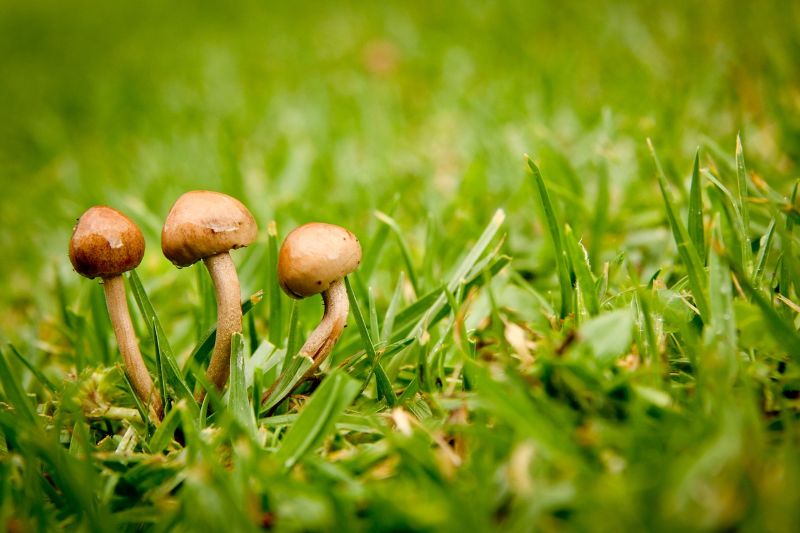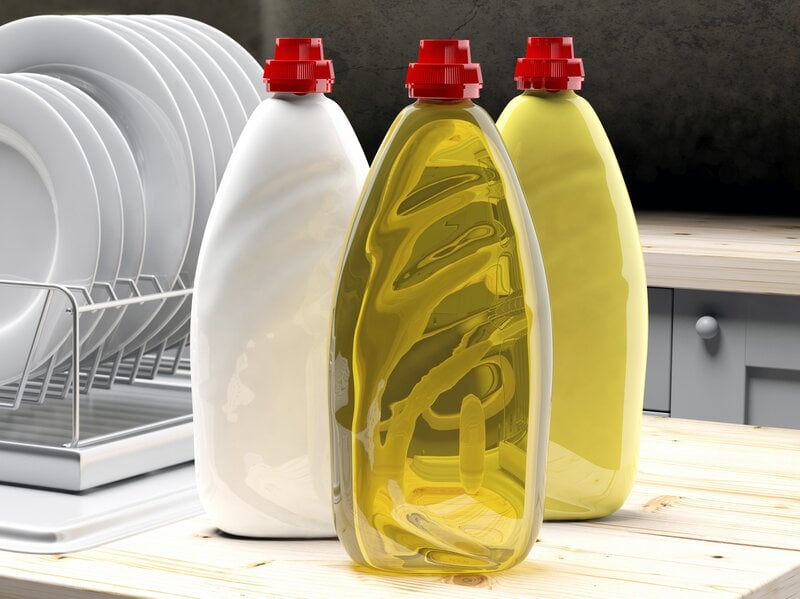
Mushrooms belong in the kitchen, not in the yard. To get rid of mushrooms in your yard, you can manually remove them or use vinegar, baking soda, dish soap, or commercial fungicides.
Apart from plucking out mushrooms and using natural solutions or chemical sprays, you can also use other methods, which we’ll explain here.
| Project Difficulty: Easy Estimated Time to Complete: Depending on the number and size of mushrooms, removing them can take a few minutes to an hour or two. Project Cost: It depends on your removal method of choice: DIY lawn fungus treatments can cost around $5 to $8 per 1,000 square feet, while hand-picking or using vinegar or dish soap will cost nothing if you already have garden gloves and these household products. |
Why are Mushrooms Growing in Your Yard?

A natural part of the ecosystem, mushrooms grow in yards when the conditions provide the perfect environment for fungal networks – called mycelium – to produce their fruiting bodies. While these mushrooms indicate a healthy soil system, they can make your yard look neglected, so you’ll want to remove them immediately.
Before we get into the nitty-gritty details on how to get rid of mushrooms in your lawn, you must first understand where they come from and how they grow. Several factors can cause mushrooms in your yard, including:
- Moisture
- Shade
- Rich, organic material
- Poor drainage
- Excess thatch
- Underground fungal networks
Check out our article What Causes Mushrooms in My Yard? to learn more about why these fungi grow in your lawn.
Note: To prevent mushrooms in your yard, have a local lawn care pro maintain your yard.
How to Get Rid of Mushrooms in Your Lawn

For an average person, it can be difficult to distinguish the non-toxic from the poisonous lawn mushroom types, as different mushroom varieties can look very similar. Unless you’re sure no one in your family will touch them, it’s best to know how to kill mushrooms in your yard.
An effortless solution would be to wait it out, as mushrooms can disappear on their own when the conditions dry out after a day or two. But if you want to be proactive, here are several ways to deal with lawn mushrooms:
Manual Removal
Jeremy Kichler, county extension coordinator at the University of Georgia, advises homeowners to “remove mushrooms as soon as they sprout to prevent them from having enough time to release spores.”
- Wear gloves to avoid skin contact with spores.
- Gently twist or pull mushrooms from the base, removing the entire stem.
- Place the mushrooms in a sealed bag and toss them in the trash to prevent them from spreading, Kichler recommends. Do not compost them.
- Wash your hands and tools.
Vinegar

Thanks to its acidity, vinegar can kill weeds and mushrooms. But take extra care because it’s also strong enough to harm grass and other plants.
- Mix 1 part white vinegar with 4 parts water in a spray bottle.
- Spray directly on the mushroom caps, avoiding the surrounding grass by covering it with cardboard or landscape plastic.
- Check back in 1-2 days and reapply if needed.
Baking Soda
Baking soda raises the soil’s pH, which can impede mushroom growth.
- Mix 2 tablespoons of baking soda into a gallon of water.
- Pour the solution over the mushrooms and the surrounding area.
- Repeat every few days until the mushrooms stop reappearing.
Dish Soap

A dish soap solution can break down the fungus and remove moisture from the soil at the same time.
- Mix 2 to 3 tablespoons of dish soap with 2 gallons of water.
- Use a screwdriver or garden fork to poke holes in the soil around the mushrooms.
- Pour the soapy mix into the holes to reach the fungus underground.
- Repeat daily for about a week.
Mowing
If you don’t want to pull out the mushrooms, Kichler says you can kick them over or run over them with your lawn mower. “Mow regularly since short grass dries out quicker than tall grass,” he adds.
- Mow your lawn often to remove mushroom heads before they release spores.
- Use a grass catcher to bag the grass clippings and avoid spreading spores around.
- Afterward, clean your mower deck to avoid reintroducing the fungus.
Reduce Moisture

Drying out the yard removes the damp environment where mushrooms thrive.
- Fix leaking sprinkler heads or hoses.
- Aerate compacted soil to help it dry faster.
Pro Tip: You’ll want to get rid of standing water in your yard, as it can soak into the soil and easily turn into a fungal hotspot.
If you get a lot of rain year-round, Gabrielle LaTora, agriculture and natural resources agent from the University of Georgia, recommends installing dry creek beds, French drains, rain barrels, and rain gardens to help slow down, spread out, and soak up the stormwater.
See Related:
Reduce Shade
Kichler suggests “to keep shade to a minimum so that sunlight can reach the lawn.”
- Trim overgrown trees and shrubs.
- Thin out dense branches to allow sunlight to reach the ground.
- Keep shaded areas free of leaves and debris.
Pro Tip: Another option is to build a shade garden in areas under dense trees that never get enough sunlight. While it won’t get rid of the mushrooms, it will make them less conspicuous if they’re covered with hostas, grasses, and tall groundcovers.
Remove Organic Matter

Reducing decaying material on the soil means less food for the mushrooms.
- Rake up old mulch, leaves, and grass clippings.
- Use stone or rubber mulch instead of wood if mushrooms are persistent.
- Dethatch your lawn if there’s a thick layer of dead grass.
- You can also remove tree stumps or roots that may be feeding the fungi.
See Related:
Commercial Fungicides
If the other methods don’t work, you might need to apply a lawn fungicide as a last resort.
- Choose a fungicide labeled for yard mushrooms or lawn fungi.
- Follow the product instructions carefully, such as the dosage, safety, and timing.
- Apply evenly over affected areas and water in if required.
- Check the label to see how long you’ll need to keep kids and pets off the treated areas.
FAQ About Getting Rid of Mushrooms

Photo Credit: Pixabay
The most common types of lawn mushrooms are fairy ring mushrooms, puffballs, and inky caps.
No, we strongly discourage eating lawn mushrooms, even if you know how to identify them. They may look similar to food-grade mushrooms, but it’s best not to take chances because most types are toxic.
No, mushrooms do not have the same roots as what you find in plants. Instead, they have what is called mycelium — a network of thin, thread-like filaments that act the same way as the roots of plants.
Let the Pros Handle the Mushrooms in Your Yard
Staying on top of moisture, shade, and organic matter goes a long way to keep your lawn healthy and fungus-free. While you can get rid of mushrooms in your yard yourself, sometimes the problem runs deeper than what you can handle. That’s why it’s always best to reach out to a local lawn care pro to help you deal with the issue.
Sources:
- Gabrielle LaTora, agriculture and natural resources agent at the University of Georgia Extension Fulton County. Personal interview.
- “How Do I Get Rid of Mushrooms in my Yard or Garden Bed?” By Aaron Steil, consumer horticulture extension specialist. Iowa State University Extension and Outreach.
- “I Have a Bunch of Mushrooms in the Yard!!!” By Jeremy Kichler, extension coordinator. University of Georgia Extension.
- Jeremy Kichler, county extension coordinator at the University of Georgia. Personal interview.
- “Managing Mushroom Growth in Home Lawns.” By Madalyn Shires, assistant professor and plant pathology specialist. South Dakota State University Extension.
- “Managing Mushrooms in the Lawn.” Virginia Cooperative Extension.
- “Mushrooms in the Garden Beds.” Texas A&M University Agrilife Extension.
- “What Can I Do About Mushrooms in My Yard?” By Charlotte Glen, statewide coordinator. North Carolina Cooperative Extension.
- “Why Mushrooms Grow In My Yard (Sometimes).” By Justin Moore, marketing and communications director. North Carolina State University Extension.
Main Photo Credit: Pixabay